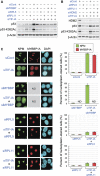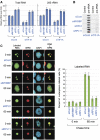RNA content in the nucleolus alters p53 acetylation via MYBBP1A
- PMID: 21297583
- PMCID: PMC3061030
- DOI: 10.1038/emboj.2011.23
RNA content in the nucleolus alters p53 acetylation via MYBBP1A
Abstract
A number of external and internal insults disrupt nucleolar structure, and the resulting nucleolar stress stabilizes and activates p53. We show here that nucleolar disruption induces acetylation and accumulation of p53 without phosphorylation. We identified three nucleolar proteins, MYBBP1A, RPL5, and RPL11, involved in p53 acetylation and accumulation. MYBBP1A was tethered to the nucleolus through nucleolar RNA. When rRNA transcription was suppressed by nucleolar stress, MYBBP1A translocated to the nucleoplasm and facilitated p53-p300 interaction to enhance p53 acetylation. We also found that RPL5 and RPL11 were required for rRNA export from the nucleolus. Depletion of RPL5 or RPL11 blocked rRNA export and counteracted reduction of nucleolar RNA levels caused by inhibition of rRNA transcription. As a result, RPL5 or RPL11 depletion inhibited MYBBP1A translocation and p53 activation. Our observations indicated that a dynamic equilibrium between RNA generation and export regulated nucleolar RNA content. Perturbation of this balance by nucleolar stress altered the nucleolar RNA content and modulated p53 activity.
Conflict of interest statement
The authors declare that they have no conflict of interest.
Figures







Similar articles
-
The nucleolar protein Myb-binding protein 1A (MYBBP1A) enhances p53 tetramerization and acetylation in response to nucleolar disruption.J Biol Chem. 2014 Feb 21;289(8):4928-40. doi: 10.1074/jbc.M113.474049. Epub 2013 Dec 27. J Biol Chem. 2014. PMID: 24375404 Free PMC article.
-
Gradual reduction in rRNA transcription triggers p53 acetylation and apoptosis via MYBBP1A.Sci Rep. 2015 Jun 5;5:10854. doi: 10.1038/srep10854. Sci Rep. 2015. PMID: 26044764 Free PMC article.
-
Novel nucleolar pathway connecting intracellular energy status with p53 activation.J Biol Chem. 2011 Jun 10;286(23):20861-9. doi: 10.1074/jbc.M110.209916. Epub 2011 Apr 6. J Biol Chem. 2011. PMID: 21471221 Free PMC article.
-
A new PICTure of nucleolar stress.Cancer Sci. 2012 Apr;103(4):632-7. doi: 10.1111/j.1349-7006.2012.02219.x. Epub 2012 Mar 8. Cancer Sci. 2012. PMID: 22320853 Free PMC article. Review.
-
GRWD1, a new player among oncogenesis-related ribosomal/nucleolar proteins.Cell Cycle. 2017 Aug 3;16(15):1397-1403. doi: 10.1080/15384101.2017.1338987. Epub 2017 Jul 19. Cell Cycle. 2017. PMID: 28722511 Free PMC article. Review.
Cited by
-
Epigenetic silencing of myogenic gene program by Myb-binding protein 1a suppresses myogenesis.EMBO J. 2012 Apr 4;31(7):1739-51. doi: 10.1038/emboj.2012.24. Epub 2012 Feb 14. EMBO J. 2012. PMID: 22333916 Free PMC article.
-
Downregulation of rRNA transcription triggers cell differentiation.PLoS One. 2014 May 30;9(5):e98586. doi: 10.1371/journal.pone.0098586. eCollection 2014. PLoS One. 2014. PMID: 24879416 Free PMC article.
-
Identification of novel interacting partners of Sirtuin6.PLoS One. 2012;7(12):e51555. doi: 10.1371/journal.pone.0051555. Epub 2012 Dec 11. PLoS One. 2012. PMID: 23240041 Free PMC article.
-
Epigeneitc silencing of ribosomal RNA genes by Mybbp1a.J Biomed Sci. 2012 Jun 11;19(1):57. doi: 10.1186/1423-0127-19-57. J Biomed Sci. 2012. PMID: 22686419 Free PMC article.
-
The nucleolar protein Myb-binding protein 1A (MYBBP1A) enhances p53 tetramerization and acetylation in response to nucleolar disruption.J Biol Chem. 2014 Feb 21;289(8):4928-40. doi: 10.1074/jbc.M113.474049. Epub 2013 Dec 27. J Biol Chem. 2014. PMID: 24375404 Free PMC article.
References
-
- Andersen JS, Lam YW, Leung AK, Ong SE, Lyon CE, Lamond AI, Mann M (2005) Nucleolar proteome dynamics. Nature 433: 77–83 - PubMed
-
- Appella E, Anderson CW (2001) Post-translational modifications and activation of p53 by genotoxic stresses. Eur J Biochem 268: 2764–2772 - PubMed
-
- Arva NC, Gopen TR, Talbott KE, Campbell LE, Chicas A, White DE, Bond GL, Levine AJ, Bargonetti J (2005) A chromatin-associated and transcriptionally inactive p53-Mdm2 complex occurs in mdm2 SNP309 homozygous cells. J Biol Chem 280: 26776–26787 - PubMed
Publication types
MeSH terms
Substances
LinkOut - more resources
Full Text Sources
Other Literature Sources
Molecular Biology Databases
Research Materials
Miscellaneous

